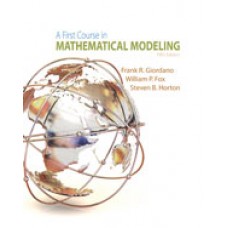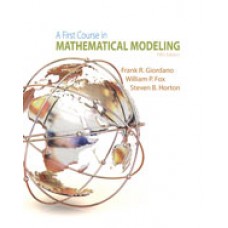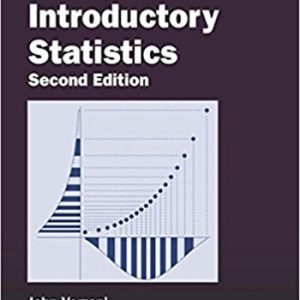This is completed downloadable of Solution Manual for A First Course in Mathematical Modeling, 5th Edition

Product Details:
- ISBN-10 : 1285050908
- ISBN-13 : 978-1285050904
- Author:
Offering a solid introduction to the entire modeling process, A FIRST COURSE IN MATHEMATICAL MODELING, 5th Edition delivers an excellent balance of theory and practice, and gives you relevant, hands-on experience developing and sharpening your modeling skills. Throughout, the book emphasizes key facets of modeling, including creative and empirical model construction, model analysis, and model research, and provides myriad opportunities for practice. The authors apply a proven six-step problem-solving process to enhance your problem-solving capabilities — whatever your level. In addition, rather than simply emphasizing the calculation step, the authors first help you learn how to identify problems, construct or select models, and figure out what data needs to be collected. By involving you in the mathematical process as early as possible — beginning with short projects — this text facilitates your progressive development and confidence in mathematics and modeling.
Table of Content:
- Ch 1: Modeling Change
- Introduction
- 1.1: Modeling Change with Difference Equations
- 1.2: Approximating Change with Difference Equations
- 1.3: Solutions to Dynamical Systems
- 1.4: Systems of Difference Equations
- Ch 2: The Modeling Process, Proportionality, and Geometric Similarity
- Introduction
- 2.1: Mathematical Models
- 2.2: Modeling Using Proportionality
- 2.3: Modeling Using Geometric Similarity
- 2.4: Automobile Gasoline Mileage
- 2.5: Body Weight and Height, Strength and Agility
- Ch 3: Model Fitting
- Introduction
- 3.1: Fitting Models to Data Graphically
- 3.2: Analytic Methods of Model Fitting
- 3.3: Applying the Least-Squares Criterion
- 3.4: Choosing a Best Model
- Ch 4: Experimental Modeling
- Introduction
- 4.1: Harvesting in the Chesapeake Bay and Other One-Term Models
- 4.2: High-Order Polynomial Models
- 4.3: Smoothing: Low-Order Polynomial Models
- 4.4: Cubic Spline Models
- Ch 5: Simulation Modeling
- Introduction
- 5.1: Simulating Deterministic Behavior: Area under a Curve
- 5.2: Generating Random Numbers
- 5.3: Simulating Probabilistic Behavior
- 5.4: Inventory Model: Gasoline and Consumer Demand
- 5.5: Queuing Models
- Ch 6: Discrete Probabilistic Modeling
- Introduction
- 6.1: Probabilistic Modeling with Discrete Systems
- 6.2: Modeling Component and System Reliability
- 6.3: Linear Regression
- Ch 7: Optimization of Discrete Models
- Introduction
- 7.1: An Overview of Optimization Modeling
- 7.2: Linear Programming I: Geometric Solutions
- 7.3: Linear Programming II: Algebraic Solutions
- 7.4: Linear Programming III: The Simplex Method
- 7.5: Linear Programming IV: Sensitivity Analysis
- 7.6: Numerical Search Methods
- Ch 8: Modeling Using Graph Theory
- Introduction
- 8.1: Graphs as Models
- 8.2: Describing Graphs
- 8.3: Graph Models
- 8.4: Using Graph Models to Solve Problems
- 8.5: Connections to Mathematical Programming
- Ch 9: Modeling with Decision Theory
- Introduction
- 9.1: Probability and Expected Value
- 9.2: Decision Trees
- 9.3: Sequential Decisions and Conditional Probabilities
- 9.4: Decisions Using Alternative Criteria
- Ch 10: Game Theory
- Introduction
- 10.1: Game Theory: Total Conflict
- 10.2: Total Conflict as a Linear Program Model: Pure and Mixed Strategies
- 10.3: Decision Theory Revisited: Games against Nature
- 10.4: Alternative Methods for Determining Pure Strategy Solutions
- 10.5: Alternative Shortcut Solution Methods for the 2 x 2 Total Conflict Game
- 10.6: Partial Conflict Games: The Classical Two-Player Games
- 10.7: Illustrative Modeling Examples
- Ch 11: Modeling with a Differential Equation
- Introduction
- 11.1: Population Growth
- 11.2: Prescribing Drug Dosage
- 11.3: Braking Distance Revisited
- 11.4: Graphical Solutions of Autonomous Differential Equations
- 11.5: Numerical Approximation Methods
- 11.6: Separation of Variables
- 11.7: Linear Equations
- Ch 12: Modeling with Systems of Differential Equations
- Introduction
- 12.1: Graphical Solutions of Autonomous Systems of First-Order Differential Equations
- 12.2: A Competitive Hunter Model
- 12.3: A Predator-Prey Model
- 12.4: Two Military Examples
- 12.5: Euler’s Method for Systems of Differential Equations
- Ch 13: Optimization of Continuous Models
- Introduction
- 13.1: An Inventory Problem: Minimizing the Cost of Delivery and Storage
- 13.2: Methods to Optimize Functions of Several Variables
- 13.3: Constrained Continuous Optimization
- 13.4: Managing Renewable Resources: The Fishing Industry
- Ch 14: Dimensional Analysis and Similitude
- Introduction
- 14.1: Dimensions as Products
- 14.2: The Process of Dimensional Analysis
- 14.3: A Damped Pendulum
- 14.4: Examples Illustrating Dimensional Analysis
- 14.5: Similitude
- Ch 15: Graphs of Functions as Models
- 15.1: An Arms Race
- 15.2: Modeling an Arms Race in Stages
- 15.3: Managing Nonrenewable Resources: The Energy Crisis
- 15.4: Effects of Taxation on the Energy Crisis
- 15.5: A Gasoline Shortage and Taxation
- Appendix A: Problems from the Mathematics Contest in Modeling, 1985-2012
- 1985: The Animal Population Problem
- 1985: The Strategic Reserve Problem
- 1986: The Hydrographic Data Problem
- 1986: The Emergency-Facilities Location Problem
- 1987: The Salt Storage Problem
- 1987: The Parking Lot Problem
- 1988: The Railroad Flatcar Problem
- 1988: The Drug Runner Problem
- 1989: The Aircraft Queuing Problem
- 1989: The Midge Classification Problem
- 1990: The Brain-Drug Problem
- 1991: The Water Tank Problem
- 1991: The Steiner Tree Problem
- 1992: The Emergency Power-Restoration Problem
- 1992: The Air-Traffic-Control Radar Problem
- 1993: The Coal-Tipple Operations Problem
- 1993: The Optimal Composting Problem
- 1994: The Concrete Slab Problem
- 1994: The Communications Network Problem
- 1995: The Single Helix
- 1995: Aluacha Balaclava College
- 1996: The Submarine Detection Problem
- 1996: The Contest Judging Problem
- 1997: The Velociraptor Problem
- 1997: Mix Well for Fruitful Discussions
- 1998: MRI Scanners
- 1998: Grade Inflation
- 1999: Deep Impact
- 1999: Unlawful Assembly
- 2000: Air Traffic Control
- 2000: Radio Channel Assignments
- 2001: Choosing a Bicycle Wheel
- 2001: Escaping a Hurricane’s Wrath
- 2002: Wind and Waterspray
- 2002: Airline Overbooking
- 2003: The Stunt Person
- 2003: Gamma Knife Treatment Planning
- 2004: Are Fingerprints Unique?
- 2004: A Faster QuickPass System
- 2005: Flood Planning
- 2005: Tollbooths
- 2006: Positioning and Moving Sprinkler Systems for Irrigation
- 2006: Wheelchair Access at Airports
- 2007: Gerrymandering
- 2007: The Airplane Seating Problem
- 2008: Take a Bath
- 2008: Creating Sudoku Puzzles
- 2009: Designing a Traffic Circle
- 2009: Energy and the Cell Phone
- 2010: The Sweet Spot
- 2010: Criminology
- 2011: Snowboard Course
- 2011: Repeater Coordination
- 2012: The Leaves of a Tree
- 2012: Camping along the Big Long River
- Appendix B: An Elevator Simulation Algorithm
- Appendix C: The Revised Simplex Method
- Pivoting by Matrix Inversion and Multiplication
- The Revised Simplex Method
- Appendix D: Brief Review of Integration Techniques
- u-Substitution
- Integration by Parts
- Rational Functions
- Partial Fractions
- Answers to Selected Problems
- Index





